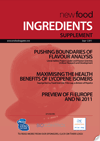Food Safety Supplement 2012
27 February 2012 | By Jessica Evans, Gun Wirtanen, Satu Salo, Ricardo F. Luna
How are lubricants affected by food safety regulations? (Jessica Evans, Business Unit Manager, Nonfood Compounds, NSF International)Microbial limits for food processing surfaces (Gun Wirtanen & Satu Salo, VTT Expert Devices)Past, present and future of food safety (Ricardo F. Luna, Senior Quality Specialist, Nestec SA)







